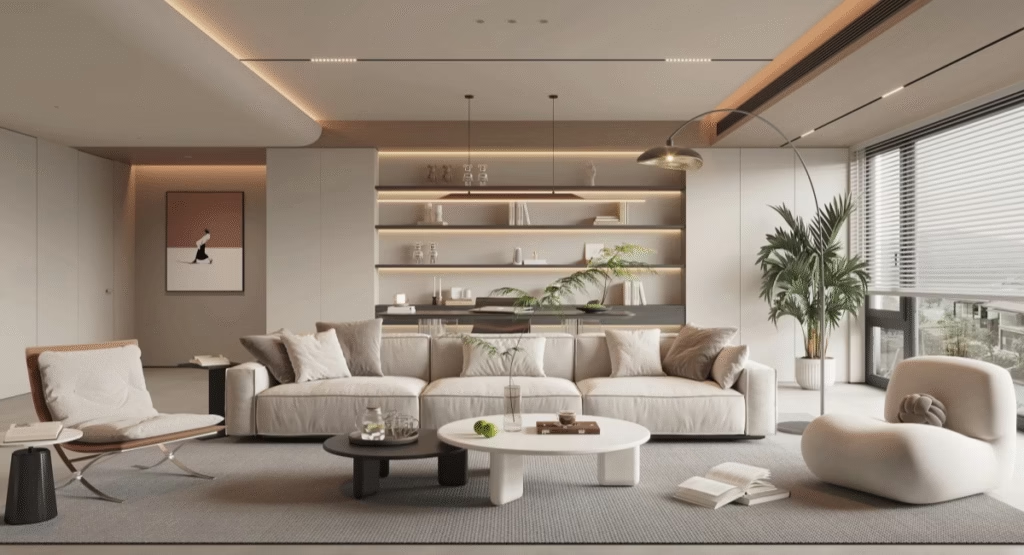Introduction: The New Era of Furniture Procurement
Over the past decade, the U.S. interior design and development landscape has gone through a quiet but profound transformation. Homeowners, boutique hotel brands, and commercial property developers are no longer satisfied with off-the-shelf solutions — they want pieces that speak to identity, craftsmanship, and story. The result is an unprecedented rise in demand for bespoke and custom furniture, pushing designers to rethink where and how they source.
At the same time, global furniture supply chains have evolved dramatically. What was once viewed as a purely cost-saving tactic — manufacturing overseas — has now become a strategic design choice. Today, U.S. designers increasingly look beyond domestic showrooms and wholesalers, collaborating directly with highly specialized furniture factories overseas to bring one-of-a-kind concepts to life.
This shift isn’t anecdotal; it reflects the convergence of several major forces shaping the industry:
- A growing emphasis on personalization and small-batch production
- Increased consumer willingness to invest in unique, well-crafted interiors
- Technological advancements that enable precision fabrication and seamless remote collaboration
- A global logistics infrastructure far more sophisticated than it was even five years ago
What was once a niche practice reserved for luxury hospitality projects has now become accessible to boutique studios, independent designers, and residential developers. Contractors working on kitchen cabinetry, whole-house millwork, and custom seating now operate in a world where CAD files travel instantly, prototypes ship quickly, and transparent digital production workflows make overseas cooperation viable and efficient.
As a result, the conversation has shifted from “Should we source globally?” to “Which overseas partner best understands our design language, material standards, and timelines?”
In this environment, the ability to collaborate with a manufacturing partner who delivers high-touch service, consistent quality control, and customization at scale has become a competitive advantage. For many U.S. designers, global sourcing isn’t simply about price — it’s about unlocking design freedom, expanding material options, and achieving artisanal quality backed by industrial precision.
The following sections explore why this movement continues to gain momentum, how the process works in practice, and what designers should consider when choosing a manufacturing partner abroad.
Rising Demand for Custom & Bespoke Furniture in the U.S.
In today’s design market, “premium” is no longer defined by brand names or catalog SKUs — it’s defined by originality, craftsmanship, and narrative. Consumers are better informed, more design-conscious, and increasingly willing to invest in interiors that feel curated rather than mass-produced.
From Standardization to Personalization
For years, standardized furniture lines satisfied mainstream demand, particularly in residential development and hospitality chains. They provided reliability, predictable lead times, and cost efficiency. But design culture has shifted:
- Homeowners expect individuality — not the same cabinetry or furniture seen in neighboring properties.
- Boutique hotels compete through design identity — not scale.
- Developers market lifestyle, not floor plans.
This cultural shift is fueled by social media aesthetics, designer-influencer culture, and the positioning of interiors as a form of personal expression. The pandemic accelerated the trend as people reconsidered how they live, work, and rest at home — leading to unprecedented investment in residential design quality.
The Limits of Domestic Options
While the U.S. has boutique studios and artisanal workshops capable of beautiful craftsmanship, the domestic market faces constraints:
| Challenge | Impact |
| Limited scalable custom production | Hard for designers to execute multi-unit projects with consistency |
| Higher labor and fabrication costs | Custom work becomes cost-prohibitive for mid-range budgets |
| Material sourcing constraints | Limited availability of certain finishes, veneers, and metals |
| Longer queues for custom shops | Slower project timelines, missed client deadlines |
These limitations don’t diminish domestic talent — they simply mean capacity doesn’t match rising demand.
Global Craftsmanship Meets U.S. Design Standards
Overseas manufacturing — once associated only with mass-production — has matured. Many factories now specialize in:
- Custom cabinetry and millwork
- Hospitality and residential furniture
- Upholstered seating & soft furniture
- Integrated storage & built-ins
And importantly, they aren’t just “producers” — they collaborate:
From CAD drawings to prototype samples and material mood boards, modern factories work hand-in-hand with designers to achieve precise execution.
A Middle Ground: Accessible Luxury
Global sourcing creates a new category — accessible luxury custom furniture.
It democratizes high-end customization by delivering artisanal finishes, premium materials, and bespoke dimensions without premium-only pricing.
For U.S. designers, this shift opens creative possibilities:
- Custom kitchen cabinetry instead of standard modular lines
- Bespoke hotel casegoods with brand storytelling
- Built-ins and millwork tailored to architecture, not forced into it
- Furniture that carries a studio’s signature — not a catalogue identity
The result isn’t just a product — it’s a differentiated portfolio, more satisfied clients, and a stronger brand narrative for designers.
Cost Efficiencies & Design Value: Why Overseas Factories Offer More Than Competitive Pricing
For many U.S. design firms, sourcing furniture overseas was once synonymous with cost reduction. But that’s no longer the full story. What started as a budget strategy has evolved into a deliberate design and production partnership that delivers better craftsmanship, broader material access, and smarter scalability.
Balancing Cost and Craftsmanship
The global furniture market has matured to the point where affordability doesn’t mean compromise. Overseas manufacturers, particularly those in Asia and parts of Europe, have invested heavily in digital fabrication, precision equipment, and design collaboration tools. These investments allow them to produce high-quality, fully customized pieces at prices that remain 30–50% below domestic equivalents.
The result? Designers can offer clients luxury-grade finishes and detailing at mid-market budgets — without cutting corners on materials or build integrity.
Design Freedom Through Direct Collaboration
Direct communication between designers and factories eliminates middlemen who often limit creative flexibility. Designers can now send 3D models, specify finishes, and review prototypes in real-time, shortening project cycles while maintaining control over every design decision.
By working with a custom home furniture manufacturer, studios gain access to a team that understands both engineering and aesthetics — bridging the gap between creative intent and production feasibility. This hands-on collaboration ensures that even the most ambitious design visions can be realized with technical accuracy and consistency.
Beyond Cost: The New Definition of Value
Value today is measured not just in dollars saved but in the quality of partnership. Reliable overseas factories provide transparency, consistent lead times, and scalable production that adapts to a firm’s evolving workload. For U.S. designers juggling multiple residential and hospitality projects, this level of dependability is often as valuable as any financial saving.
In other words, global sourcing is not simply a matter of cheaper labor — it’s about smarter collaboration and the freedom to deliver more design for the same budget.
Sustainability & Ethical Manufacturing in the Global Furniture Supply Chain
Sustainability is no longer a niche preference within the design community — it has become a defining standard of modern practice. As clients grow more conscious of material origins, carbon impact, and long-term durability, designers must ensure their sourcing partners share the same priorities. The global manufacturing ecosystem has evolved to meet this expectation, and many overseas factories are not just keeping up — they are leading.
Responsible Material Selection
Forward-thinking manufacturers now prioritize responsibly sourced timber, certified hardwoods, water-based finishes, and recyclable components. These choices do more than meet environmental certifications — they help create healthier indoor environments, which is increasingly important in residential, hospitality, and wellness-focused projects.
In practical terms, this means designers can confidently specify:
- FSC-certified wood
- Low-VOC finishes
- Eco-conscious laminates and veneers
- Recyclable metal and hardware systems
Clients gain peace of mind knowing their furniture not only looks high-end, but aligns with modern sustainability values.
Efficiency That Reduces Waste
Advanced digital fabrication and precision CNC machining have driven dramatic improvements in manufacturing efficiency. Factories can optimize raw material usage, reduce waste, and produce components with exacting accuracy — minimizing rework and transportation inefficiency.
Smart supply chain planning also helps reduce carbon emissions by consolidating shipments and using more efficient freight routes. Sustainability is now operational, not just conceptual.
Fair Labor and Ethical Production Standards
There was a time when sourcing overseas raised questions about ethical labor practices. Today, reputable global manufacturers operate with transparent labor standards, documented compliance, and modern workplace conditions.
Designers partnering directly with established factories gain visibility into:
- Workforce welfare and safety
- Fair wage systems
- Environmental compliance
- Production ethics and traceability
High-end design isn’t just about product output — it’s about integrity throughout the supply chain.
Longevity as the Ultimate Sustainable Value
The most eco-friendly design is the one that lasts. Overseas factories specializing in custom craftsmanship are producing furniture intended to live beyond trends and withstand years of daily use.
When clients invest in well-constructed cabinetry, seating, millwork, and casegoods that don’t need replacement every few years, the environmental benefit compounds over time. Sustainability, therefore, becomes synonymous with durability, precision, and thoughtful design.
How Direct Sourcing Works: From Design Concept to Finished Product
Direct global sourcing used to feel complex, reserved only for large hospitality groups and development firms with dedicated procurement teams. Today, streamlined digital workflows and global production systems have simplified the process, making it accessible to boutique interior studios, independent designers, and mid-sized developers alike.
What once required intermediaries and long paper trails can now be managed with organized communication, detailed technical drawings, and a reliable manufacturing partner.
1. Concept & Design Translation
Every project begins with the designer’s intent — sketches, mood boards, CAD files, and material references. Factories now have dedicated engineering teams who interpret creative direction into manufacturable shop drawings, ensuring design language remains intact.
Key deliverables in this phase:
2D/3D technical drawings
- Material and finish confirmations
- Dimensional and joinery detailing
- Cost estimates based on build complexity
The goal is clarity, alignment, and precision — turning creative ideas into production-ready documents.
2. Prototyping & Material Sampling
Before full production, designers receive physical samples or prototype units for approval. This step ensures finishes, stitch lines, joinery, and hardware align with expectations.
It’s a tactile checkpoint — one that reassures clients and protects project integrity.
3. Production & Quality Control
Modern overseas factories operate with layered QC systems, where every unit is inspected at multiple stages rather than only at final packing. CNC accuracy, hand-finishing excellence, and strict tolerance checks ensure quality stays consistent across single pieces and large batches.
For designers handling both residential and commercial assignments, this level of consistency is invaluable.
4. Global Logistics & Delivery Coordination
Shipping no longer feels abstract — logistics are predictable, traceable, and professionally managed.
Designers benefit from:
- Consolidated container options
- Coordinated shipment schedules
- Export-grade protective packaging
- Tracking and customs support
Combined, this results in reliable lead times and reduced transit risk.
5. Installation Support & After-Care Communication
A strong manufacturing partner doesn’t disappear after delivery. Many now support installation questions, hardware matching, and maintenance guidance — reinforcing trust and long-term collaboration.
Today’s best-performing designers don’t treat overseas sourcing as a transaction — they treat it as partnership across continents.
A Smarter, Leaner Procurement Chain
Direct sourcing cuts out layers of cost that traditionally separated designers from manufacturers. Instead of passing through agents, wholesalers, and showrooms, designers coordinate directly with a wholesale furniture supplier, gaining price efficiency, production transparency, and design control that legacy procurement models couldn’t offer.
The result?
Better material selection, tighter fabrication control, and the ability to scale creativity — whether producing a single custom vanity or furnishing an entire hospitality project.
Key Considerations When Selecting an Overseas Manufacturing Partner
While overseas sourcing offers meaningful advantages, success depends heavily on choosing the right production partner. Not all factories operate at the same standard — and selecting a manufacturer should be approached with the same diligence as selecting a design collaborator.
Technical Engineering Capabilities
Behind every beautiful furniture piece lies engineering precision. A competent manufacturer should be able to translate conceptual drawings into CNC-ready files, shop drawings, and technical detailing without compromising the design vision.
Look for partners who demonstrate:
- In-house engineering teams
- CAD / CNC compatibility
- Advanced joinery understanding
- Experience with custom builds instead of only mass production
Skilled technical execution is what separates artisanal craftsmanship from inconsistent outcomes.
Material Range & Craftsmanship Diversity
Designers increasingly need flexibility — whether it’s solid wood, veneers, stone, upholstery, metals, or mixed materials. The best partners don’t force a material limitation; they guide designers intelligently through options.
This includes:
- Access to certified timber and premium veneers
- Mastery of matte and high-gloss finishes
- Upholstery craftsmanship with premium textiles and leathers
- Ability to develop bespoke finishes as needed
A factory’s versatility reflects its commitment to innovation and premium-quality output.
Reliable QC Systems & Communication
Quality isn’t only about the finished product — it’s a process.
Strong partners communicate clearly, confirm details, and operate with multi-stage quality checks.
Signs of a reliable manufacturer:
- Clear production updates and sample approvals
- QC checkpoints at material, assembly, and finishing stages
- Dedicated account manager or project coordinator
- Transparent timeline communication
Consistency is the hallmark of a long-term furniture partner.
Scalable Capabilities for Different Project Types
Designers need flexibility — from one custom banquette to outfitting an entire boutique hotel.
Seek a partner capable of scaling production without sacrificing craftsmanship.
Key questions to evaluate:
- Can they handle both single-piece & volume orders?
- Do they offer prototypes before mass production?
- Are lead times predictable across project sizes?
A scalable partner is a strategic asset, not just a supplier.
Conclusion: A New Global Design Ecosystem
The global furniture landscape has fundamentally shifted.
U.S. designers today work in a world where craftsmanship doesn’t end at national borders — it expands across them. The most competitive studios aren’t defined by geography but by their ability to collaborate, adapt, and bring truly personalized design to life.
Direct partnerships with custom furniture factories have opened creative and economic opportunities that were once limited to luxury hospitality brands. Now, boutique firms, developer-designers, and independent studios can all access precision craftsmanship, richer material libraries, and scalable production — without compromising budget or vision.
In this new design reality, success is shaped by thoughtful sourcing, transparent communication, and selecting manufacturing partners who treat each project not as a transaction, but as shared creative craft.
The designers who thrive in the next decade won’t be the ones with the largest showroom networks —they’ll be the ones with the strongest global collaborations and the most agile production ecosystems.





